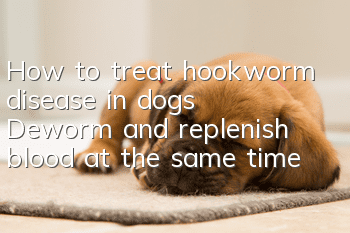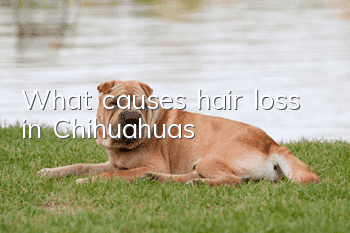How to treat hookworm disease in dogs? Deworm and replenish blood at the same time

Canine hookworm diseaseThe pathogen and its life history
The common pathogens causing canine hookworm disease are Ancylostoma caninum and Ancylostoma canis.
Canine hookworm is a small yellow-white nematode. Its head is slightly bent dorsally. The oral pouches are well developed. There are three canine teeth on both sides of the front of the oral cavity. Each tooth hooks inward. Males are 10-12 mm long and females are 14-16 mm long. The ends of hookworms are slightly thinner and smaller than the ends of hookworm canids. There is a half-moon cross section ventral to the front edge of the oral cavity. Males are 5-8.5 mm long and females are 7-10 mm long.
Canine hookworm eggs are excreted in the feces. Under suitable conditions, the larvae (rod-shaped larvae) hatch out in 12 to 30 hours, and then transform into infective larvae (sheathed filamentous larvae) in about 1 week. Dogs are usually infected through the mouth, but can also be infected through the skin and oral mucosa. When the larvae enter the body of the host worm through the mouth, they stay in the intestine, take off the sheath, and gradually develop into adult worms. When the larvae invade through the skin, they burrow into peripheral blood vessels, migrate to the alveoli and trachea, enter the mouth with sputum, and develop into adult worms in the small intestine after swallowing. Canine hookworm can also be infected through the placenta and colostrum. The life history of Ancylostoma stenoceicus is similar to that of Ancylostoma canis, but oral infection is more common.
Key points for diagnosis of hookworm disease in dogs
1. Clinical symptoms: In severe infection, the mucous membranes will be pale and emaciated, and the coat will be thick, dull, and easy to fall off. Loss of appetite, heterophilia, vomiting, digestive disorders, alternating episodes of diarrhea and constipation. The feces may be bloody or black, and in severe cases may be tar-like, with a rancid smell. If the larvae invade through the skin, the skin will become inflamed and itchy. Some limbs may be swollen and later ulcerated, or the corners of the mouth may be eroded. Puppies under 3 weeks old that are infected with hookworm in the womb or colostrum can cause severe anemia, leading to coma and death.
2. Laboratory examination: The saturated salt water flotation method can be used to check the eggs in the feces for diagnosis.
Treatment measures for dog hookworm
Anthelmintic: The commercially available preparation is 4.5% diiodonitrophenol solution, and the subcutaneous injection dose is 0.22 ml (10 mg) per kilogram of body weight. . The repellent effect of dogs on various hookworms is close to 100%. This medicine is not effective in treating canine roundworms, whipworms, tapeworms and paragonimiasis. In addition, levopyrimidine, toluidine and pyrimidine can also be used in insecticidal treatments. The dosage of lepiperidine can be referred to canine ascariasis. Severe anemia also requires symptomatic treatment, oral or injectable iron supplements, or blood transfusions.
Generally, internal anthelmintic drugs are used regularly. It is recommended to use imported anthelmintic drugs to avoid most internal parasites.
- Why do dogs bite with their mouths instead of scratching with their hands when they fight?
- The dog is short of breath, has a rumbling stomach, and has no energy.
- How many kilograms can a Bichon bear grow at maximum?
- How old is a bear before you can eat dry dog food?
- Can Samoyeds eat crab shells?
- Will Chuanchuan dogs protect their owners? Protecting their owners has nothing to do with the breed!
- A dog’s personality when sleeping with his belly up. A dog’s sleeping position represents the dog’s personality.
- How old is a dog’s headshot? The owner’s help and care are crucial during the headshot stage!
- How can office workers raise a dog? Who says raising a dog and being busy can’t be at the same time!
- Can you beat a dog if it misbehaves? Beating and scolding will not solve any problem at all.



